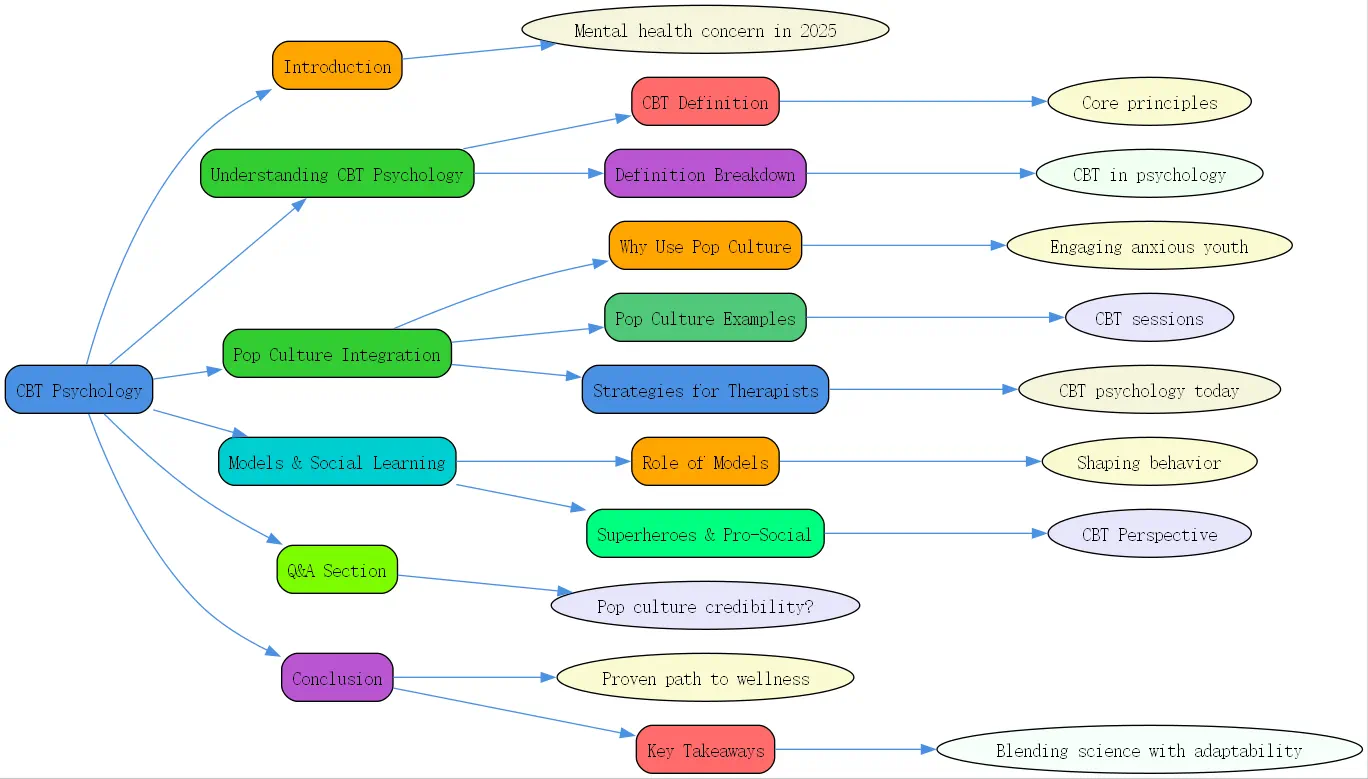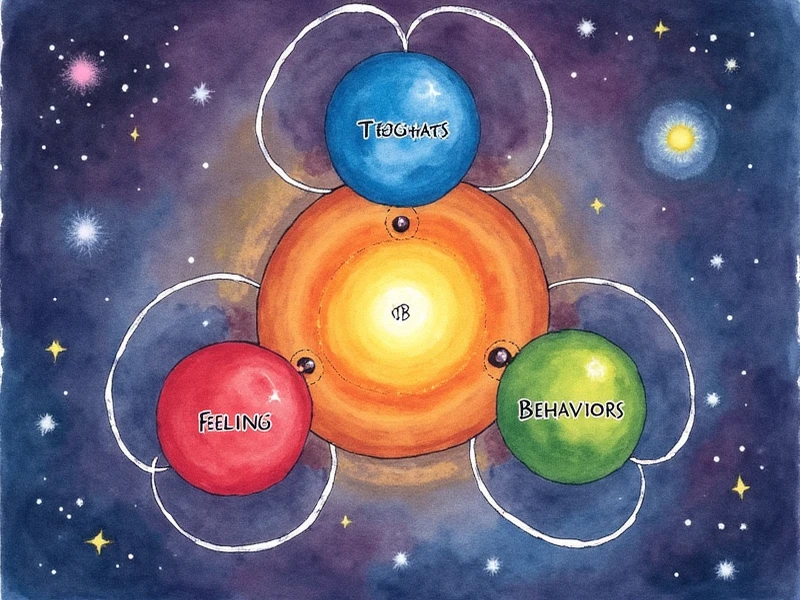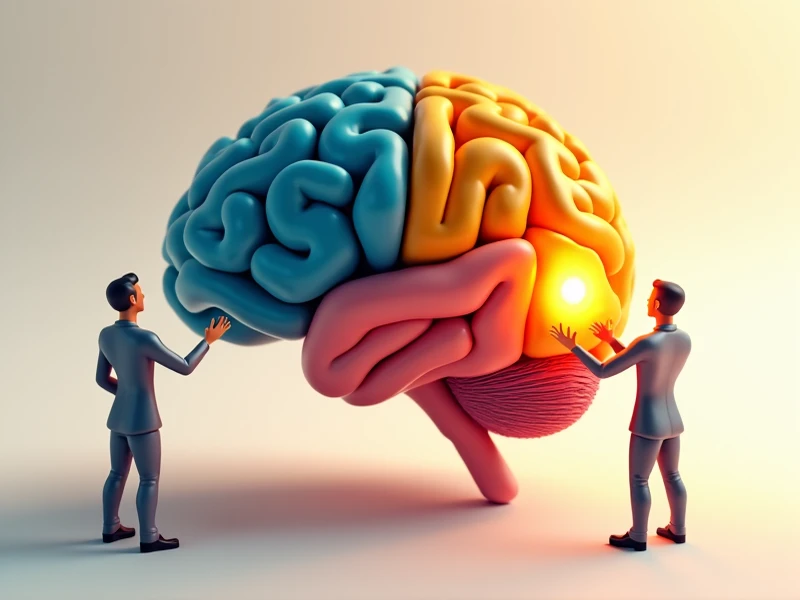Introduction

In 2025, mental health remains a pressing concern, especially for young people navigating a fast-paced world. At BrainTalking, we’re passionate about innovative solutions like Cognitive Behavioral Therapy (CBT), a cornerstone of modern psychology. Known as CBT psychology, this evidence-based approach helps individuals reshape negative thoughts and behaviors. This article dives into its definition, core techniques, and a fresh twist—using pop culture to connect with anxious youth in therapy. Let’s explore how this blend can transform mental wellness.
Understanding CBT Psychology: A Comprehensive Guide
CBT Psychology Definition and Core Principles
CBT psychology is a structured, goal-oriented form of psychotherapy designed to address mental health challenges by altering thought patterns. Developed in the 1960s by Dr. Aaron Beck, it’s grounded in the idea that our thoughts, emotions, and behaviors are linked. By reframing negative thinking, individuals can improve their emotional well-being and actions. Today, CBT psychology stands as a gold standard, backed by decades of research showing its effectiveness for anxiety, depression, and more, according to the American Psychological Association.
What makes CBT unique? It’s practical and present-focused, emphasizing solutions over dwelling on the past. Therapists work with clients to identify distorted thoughts—like “I’m a failure”—and replace them with balanced perspectives. This process, often called the CBT triangle, illustrates how tweaking one element (thoughts) can shift the others (feelings and behaviors). Its adaptability ensures CBT psychology today remains relevant across age groups and conditions, making it a go-to for professionals worldwide.
The Definition of CBT in Psychology: Breaking it Down
The definition of CBT in psychology highlights its focus on actionable change through specific techniques. Cognitive restructuring, for instance, teaches clients to challenge irrational beliefs, like assuming the worst in every situation. Exposure therapy, another key method, helps individuals face fears gradually—a proven strategy within anxiety management techniques psychology. Behavioral activation rounds out the toolkit, encouraging activities that boost mood and motivation, such as reconnecting with hobbies.
Unlike some therapies that explore childhood roots, CBT zeroes in on the “here and now.” It’s distinct for its structured sessions and homework, like journaling thoughts, which empower clients to take charge of their progress. The definition of CBT in psychology also underscores its evidence base—studies show it outperforms many alternatives for anxiety disorders. This blend of practicality and science keeps CBT psychology today a dynamic force in mental health care.
Integrating Pop Culture into CBT for Anxious Youth
Why Use Pop Culture in CBT Psychology?
Pop culture—think movies, music, and social media—offers a powerful way to make CBT psychology relatable for anxious youth. It taps into their world, turning abstract concepts into familiar stories. Dr. Sandra Pimentel, a leading expert, emphasizes that shared cultural references build rapport, easing the stigma around therapy. Beyond engagement, pop culture fosters “social surrogacy,” a sense of belonging that research links to reduced isolation, per studies from Derrick and Gabriel.
For teens glued to screens, discussing a favorite show can feel less clinical than traditional talk therapy. It’s a bridge to understanding how thoughts shape feelings, using characters they already connect with. This approach not only demystifies CBT but also leverages the emotional investment youth have in media. By meeting them where they are, therapists can transform sessions into something approachable and even fun.
Examples of Pop Culture Integration in CBT Sessions
Picture a teen relating Spider-Man’s anxiety over responsibility to their own school stress. In CBT, this superhero’s journey can model exposure therapy—facing fears step-by-step. Or consider athletes like Simone Biles, who’ve shared mental health struggles, inspiring youth to adopt coping skills like mindfulness. Music, too, plays a role; a Taylor Swift lyric about heartbreak might spark a discussion on reframing negative self-talk, a core CBT technique.
TV shows offer rich examples as well. A character from “Stranger Things” overcoming trauma can mirror a client’s path through behavioral activation—reclaiming joy after fear. These references aren’t random; they’re tailored to the client’s interests, making therapy a collaborative adventure. By weaving in pop culture, therapists illustrate the cbt psychology definition in action, showing how everyday heroes tackle challenges youth face.

Practical Strategies for Therapists: CBT Psychology Today
Therapists can harness CBT psychology today by staying current with trends—scroll TikTok or binge a Netflix hit to know what resonates. Start by asking clients about their favorite media, then tie it to CBT goals. For example, create a “Superhero Challenge” where teens design alter egos with strengths like courage, reflecting qualities they want to build. This activity reinforces positive behavior while keeping sessions lively.
Balance is key, though. Pop culture should enhance, not overshadow, evidence-based methods like anxiety management techniques psychology. Avoid over-familiarity—keep boundaries clear and focus on therapeutic outcomes. Dr. Pimentel suggests blending fun with structure, ensuring references serve the client’s growth. With creativity and care, therapists can make CBT a dynamic tool for today’s youth.

The Impact of Models and Social Learning in CBT Psychology

The Role of Models in Shaping Behavior
Albert Bandura’s Social Learning Theory underpins much of CBT psychology, showing that we learn by observing others. Models—whether parents, peers, or fictional characters—shape how youth see the world. In therapy, positive role models can inspire change. A teen watching a sports icon discuss resilience might adopt similar grit, aligning with CBT’s focus on behavior shifts through observation and practice.
Real or imagined, these figures influence more than actions—they affect self-perception. A shy kid might emulate a confident TV character, practicing new social skills. Research backs this: studies from Houston and Berga show media models boost belonging, a buffer against anxiety. By integrating such examples, therapists amplify CBT’s impact, making abstract concepts concrete and relatable for young clients.
Superheroes and Pro-Social Behavior: A CBT Perspective
Superheroes aren’t just entertainment—they’re CBT goldmines. Research from 2025 shows kids primed with superhero imagery are more likely to help others, like picking up dropped pencils after a game. Why? Heroes like Captain America embody pro-social traits—courage, kindness—that CBT can reinforce. Therapists might ask clients to channel their inner hero during exposure tasks, turning fear into a challenge worth facing.
Take Batman’s resilience after loss—it’s a narrative teens can mirror to build their own strength. Practical exercises, like crafting a superhero persona, let clients visualize overcoming obstacles, tying into the cbt definition psychology. This approach not only boosts engagement but also fosters altruism and confidence, proving pop culture’s therapeutic power when paired with CBT principles.
Q&A Section
Q: How can therapists use pop culture in CBT without losing credibility?
A: Therapists maintain credibility by aligning pop culture with CBT’s evidence-based framework. Use references—like a superhero’s grit—to illustrate techniques such as cognitive restructuring, not as gimmicks. Keep discussions client-centered, ensuring relevance to their goals, like mastering anxiety management techniques psychology. Studies show this boosts engagement without diluting professionalism, as long as boundaries stay firm and the focus remains therapeutic, per experts like Dr. Pimentel.
Conclusion
Key Takeaways
- CBT psychology links thoughts, feelings, and behaviors for lasting change.
- Pop culture makes therapy engaging, using familiar stories to teach skills.
- Models, real or fictional, drive behavior shifts in CBT.
- Therapists balance fun and professionalism for effective sessions.




